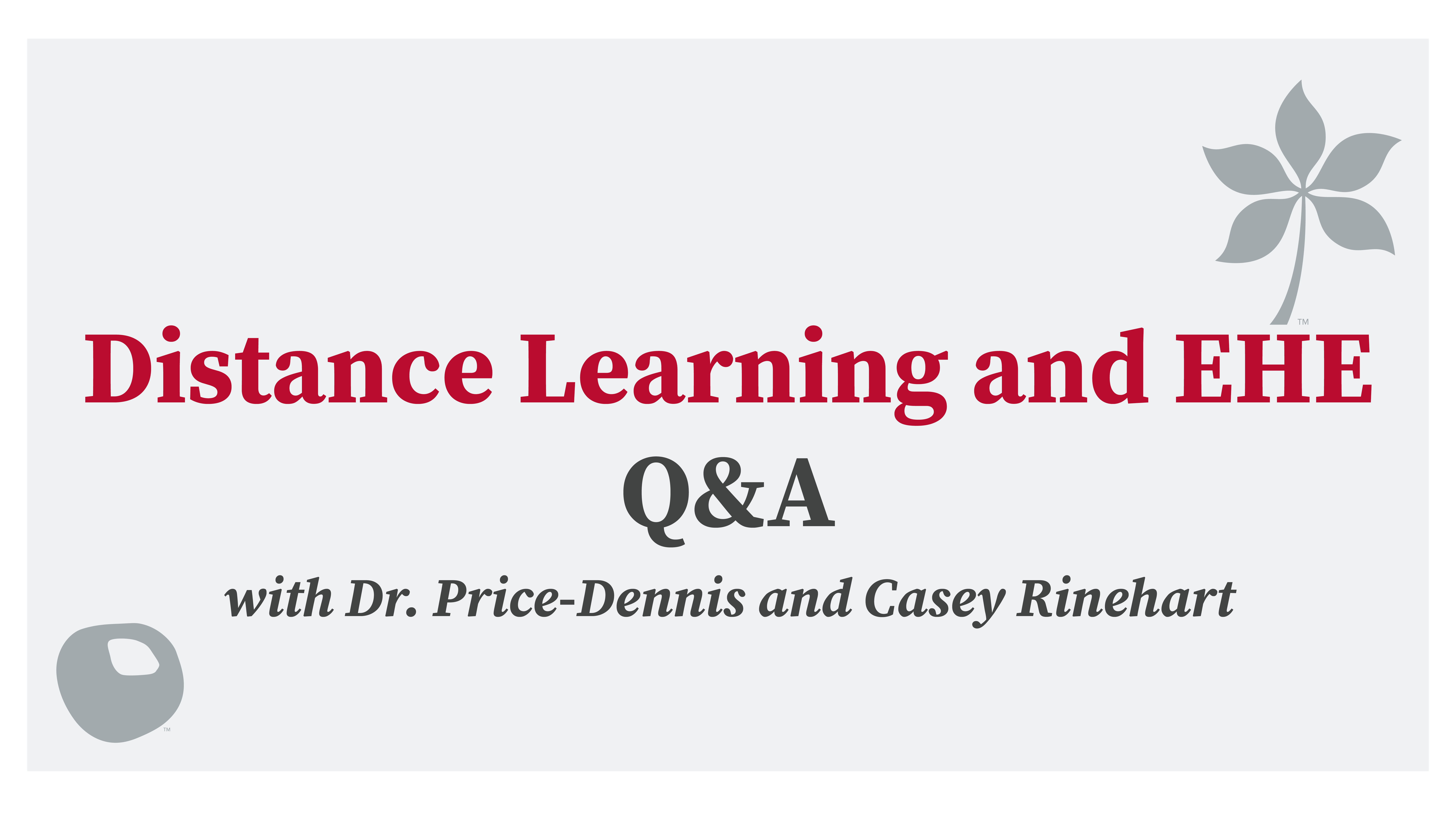World Distance Learning Day promotes teaching and learning that occurs outside of the traditional, in-person classroom. The College of Education and Human Ecology is a leader in educational innovation in the digital sphere, and to commemorate this awareness day, we asked Dr. Detra Price-Dennis and Casey Rinehart to share more about the work they are leading in this arena.


Detra Price-Dennis, Ph.D
Can you share a little bit about your role in the college as it relates to distance learning?
“I am the Executive Director for the Center for Digital Learning and Innovation. In this role, I work with an incredible team to create transformative learning experiences with technologies that evoke creativity and innovation in the fields of education and human ecology. I also provide strategic direction for the college related to our distance education plan and manage the daily operations for the center.”
What are the benefits/challenges of distance learning since the onset of COVID-19?
Distance learning, also known as online learning or remote education, experienced a surge due to the COVID-19 pandemic. While there have been challenges associated with the sudden shift to remote learning, there are also several benefits that have emerged because of this educational approach. Below are some key benefits and some challenges:
- Benefits
- Flexibility in learning: Students can learn at the own pace and schedule. The number of new and improved eLearning tools expanded greatly during the pandemic in response to the needs of teachers and learning, providing even more options in this area. This is particularly advantageous for people who have other responsibilities such as work, caregiving, or personal commitments.
- Multimodal learning: Online courses often incorporate a variety of multimedia resources, such as videos, interactive simulations, and interactive online quizzes. This approach offers a variety of modalities for students to access content, connect with other students through digital tools, and create representations of their learning in modes that best represent their thinking.
- Access to experts: One of my favorite benefits is being able to connect students with experts around the globe in my online courses. We can invite scholars, industry representatives, and community members to join us and share their ideas synchronously or asynchronously.
- Innovative teaching methods: Faculty can experiment with instructional strategies that leverage the affordances of technology in ways that are not possible when teaching F2F. Online learning provides a great opportunity to reimagine our teaching for the digital age.
- Challenges
- Time management: Online teaching puts the learner in control of the pace of the course. However, many students have not been taught how to manage their time for online courses and some fall behind and struggle to catch up with their workload. We can address this issue through advisement, student support services, and periodic check-ins with the course instructor.
- Reliable technology and internet access: Students who live in areas without reliable internet access will face challenges in online courses. During the pandemic, students were trying to join synchronous class sessions while their roommates or family members were also trying to join work calls and classes. Many of us learned that everyone in the home could not have their cameras on and participate if everyone was trying to do so at the same time. I was living in NYC and this was a big issue in my home as well. Digital equity is an issue in our society that we must work collectively to address if we want to continue to push forward innovation in online learning for all communities.
- Building community: At the beginning of the pandemic, many instructors who were not prepared to teach online struggled with building community in their courses and establishing a strong presence in the course. Students felt isolated and disconnected from the community they would have created if the course was in-person and thus some people still believe it is not possible to do this work well. This disposition often creates a challenge in finding faculty with the skill set and willingness to teach online. We have a lot of work to do to build support faculty cultivating a robust and responsive digital pedagogy.
Overall, any approach to teaching and learning will have benefits and challenges. EHE is poised to drive the conversation about what the future of teaching and learning could look like when it is done well and is responsive to the evolving needs of our current and future students.
How can distance learning support students and families in PreK-12 learning contexts?
Distance learning can offer students and families more flexibility in how they engage with content and leverage the multimodal capabilities of learning with digital tools. During the pandemic, many educators were operating on emergency mode, trying their best to do the same in-person pedagogy online and it didn’t work. One of the many affordances of distance learning is that educators have an infinite number of options available to personalize learning experiences for students that provide opportunities to examine, analyze, and make connections between their community and the content they are learning in ways that position students are creators and producers of knowledge and not just passive consumers.
Several other factors that support students and families are accessibility to content, potential to increase family involvement, growth in digital literacy skills, practices, and positive dispositions, and access to content and learning experiences that are not foregrounded in many K-12 schools adopted curricula.
My experience with distance education in K-12 learning contexts and my research in this area point many possibilities that provide more choice and voice to students and families, creative options for expressing knowledge about content, and increased experiences working with other learners around the globe on similar issues that are being addressed in your own community.
What are the opportunities for innovation in distance learning at EHE, OSU or in education more broadly?
We have an opportunity to reimagine our pedagogy for distance learning at EHE in ways that highlight our faculty and instructors’ creativity and invested in meeting the needs of learners. We have opportunities to meet in the Metaverse, incorporate gamification using XR technologies, explore AI, and invite students to collaborate with community organizations, schools, and researchers around the globe to address pressing issues in education.
The Center for Digital Learning and Innovation is creating opportunities to engage faculty in discussions about creativity and innovation through our upcoming Faculty Innovation Fellows program, Tech Sandbox workshops, and professional development opportunities designed to engage faculty in conversations and experiences that center innovation in their teaching. I am excited to work with faculty to better understand how we can translate our research about equity in education through distance learning at the college.
What are some of the challenges to equity and inclusion present in the distance learning landscape?
There are several big challenges to equity and inclusion present in the distance learning landscape. An equity-oriented approach to distance education would include identifying, being responsive, and developing opportunities with technologies that address systematic issues of exclusion that learners must navigate. I mentioned a few of these in my earlier response and I would add to that access to broadband or stable internet with a digital tool that can handle the CPU requirements to run platforms for some of the eLearning tools. Another issue is making sure apps and platforms that fall under emerging technologies meet accessibility requirements (many often do not), and then making sure faculty are aware of this information so they do not incorporate tools in their teaching that could further marginalize our students. Two other challenges are developing policies or guidelines that address concerns without limiting innovation and making sure students feel like they are part of a community of learners.

Casey Rinehart
Can you share a little bit about your role in the college as it relates to distance learning?
“Within EHE’s Center for Digital Learning and Innovation, I am the director of Distance Education and Learning Design (DELD). Our DELD team is comprised of 3 instructional designers, 1 video producer, and 1 program and system administrator for Scarlet. The focus of our team is to support all EHE educators in providing high-quality, learner-centric, and inclusive online educational experiences.”
What are some distance learning resources or courses that may be useful for the students, staff, and faculty of EHE?
Over the past few years the DELD team has worked to create and curate a range of distance learning resources for faculty and staff on our website, ranging from online teaching, multimedia for learning, and carmen resources. In addition, we are a contributing partner to Ohio State’s Teaching and Learning Resource Center, aimed at providing Ohio State educators with teaching and learning strategies, curated resources, and learning opportunities. If you aren’t sure where to start, I think the best resource for faculty and staff is our team! We have a great team who are passionate about what we do and excited to support EHE educators. (meet with the DELD team)
What are the benefits/challenges of distance learning since the onset of COVID-19?
COVID-19 had a very distinct impact on distance learning. Prior to the pandemic I was beginning to witness the growth and change in narrative around distance education. Through the advancement in eLearning technologies and pedagogy-focused approaches, I think people were starting to see the amazing benefits of distance learning. With the sudden onset of the pandemic, all education was forced into the online space without proper warning and resources. Everyone truly did their best to keep the learning experience afloat. At the time we called it online education, but this was really emergency remote teaching. The difference between the two is that remote teaching is picking up an in-person course and delivering it remotely. Conversely, an online course has been purposely designed for the distance learning experience through application of specific distance learning principles, digital pedagogy, and eLearning tools. I see this as the biggest challenge in distance learning since the onset of COVID, getting us away from remote teaching and back to true online education. A further challenge is rewriting the narrative, so many (educators, learners, parents) had negative experiences from emergency remote teaching. We must work to show them that the experience can be better, they can have a meaningful experience through true online education. That said, there have also been great benefits to distance learning since the onset of COVID. These include online education awareness, eLearning tool advancement and innovation, and increasingly impactful research around distance learning. The future of distance learning is taking shape and I’m excited to play a role in advancing these educational experiences at Ohio State.
Does distance learning bring more equity to education in the US? Globally?
Distance learning has the ability to increase access to education both in the US and globally. This increased access opens the door for creating equitable educational experiences. However, creating experiences that are truly equitable requires intention by the content creator and course designer, simply putting something online does not automatically mean it is more equitable. For example, a fully online course has the potential to allow anyone, anywhere, to take advantage. However, if that fully online course requires live synchronous sessions it is likely to restrict access to individuals in other time zones, working professionals, or individuals without equal access to technology or reliable internet. Digital accessibility also impacts equity, like alternative text for images and captioning of videos, just to name a few. An instructional designer can assist in this capacity, offering solutions and support for delivering a more equitable course. Like with any course, it is crucial that content creators review course materials with consideration to areas that may create barriers or hurdles for any student. Course readings are a great place to start, considering if readings are from varied perspectives, authored by individuals of color, and that multiple voices are represented. Another recommended step would be reviewing representation in other forms of content delivery (images, videos, podcasts, etc.). Though distance learning creates an opportunity to deliver more equitable education, it’s up to us to deliver a truly equitable experience.
What are the opportunities for innovation in distance learning at EHE, OSU or in education more broadly?
To me, innovation in distance learning is unique to each educator. I know that the word innovation can feel overwhelming for some and, when added to the task of tackling distance learning, can seem insurmountable. But innovation doesn’t have to be scary! Yes, innovation in distance education can be the use of new eLearning technologies or new teaching strategies. However, innovation can also be approached more simply by reconceptualizing current strategies. For example, instead of doing a 1-hour recorded lecture, create micro-learnings by breaking up the content into bite-sized chunks like interspersing short videos with text, images, and low-stakes knowledge checks to create a more interactive and engaging experience. I also love to innovate by thinking about new ways to use an existing tool. For example, instead of using a discussion board for only text-based discussions, have learners only post video or audio responses, or even consider having learners post responses using gifs or memes. I believe the opportunities for innovation are both endless and exciting, I’m thrilled to support educators through this journey!

